|
If you are not familiar with SEM it is strongly recommended you work
your way through the
Path
Analysis tutorial and example prior to working through this
tutorial and example.
Continuation of the previous tutorial notes
regarding SEM.
XIII. Structural
Equation Modeling
(SEM) using PROC CALIS
First, let's take a moment to review our fictional*
model. Our model consists of 13 manifest variables which are assumed to
measure four latent factors. The first latent factor, Personality, is
assumed to be measured by Extroversion (extro), Openness (open), and
Agreeableness (agree). The second latent factor, Engagement, is assumed
to be measured by Social Engagement (social), Cognitive Engagement
(cognitive), Physical Engagement (physical), and Cultural Engagement
(cultural). The third latent factor, Crystallized Intelligence, is
assumed to be measured by the established tests of Vocabulary (vocab),
Abstruse Analogies (abstruse), and Block Design (block). The fourth
latent factor, Fluid Intelligence, is assumed to be measured by the
established tests of Common Analogies (common), Letter Sets (sets), and
Letter Series (series). The general research question for our fictional
longitudinal study concerns whether or not certain personality traits
cause persons to lead an engaged lifestyle, and do these personality
traits and leading an engaged lifestyle prevent loss of cognitive
functioning in late life (e.g. beyond 65 years of age).
*Again; this is a fictional example; it
includes simulated data and is not meant to be taken seriously as a
research finding supported by empirical evidence. It is
merely used here for instructional example purposes.

If you are unfamiliar with standard path and
structural equation models; there are a few things you should take note
of in our diagram that tend to be seen in published materials
displaying path models and structural equation models. First, the use
of squares or rectangles to denote observed or measured variables
(often referred to as manifest variables or indicator variables).
Second, the use of circles or ellipses to denote unobserved or latent
variables (often referred to as latent factors). Third, the use of
straight, single headed arrows to denote causal relationships. There
are two types of causal relationships shown in most diagrams. The
assumed causal relationship between a latent factor and its indicator
or manifest variables which are often referred to as loadings or factor
loadings or factor coefficients. The hypothesized causal relationship
between two latent factors which are often referred to as paths or path
loadings or path coefficients. And fourth, the use of curved,
double-headed arrows to refer to bi-directional relationships (often
referred to as correlations or covariances). Specific hypotheses should
be used to clarify what the researcher expects to find (e.g. a positive
bi-directional relationship or correlation between Crystallized
& Fluid Intelligences).
From this point forward, we will use the term loading
to refer to a relationship between a manifest
variable and a latent factor. We will use the term path
to refer to the relationship between two latent factors.
Something to consider when conducting SEM is the
recommendation of using a two stage process to conduct the SEM
(Anderson & Gerbing, 1988). When using two stages, the first
stage is used to verify the measurement model. Verification of the
measurement model in SEM can be considered analogous to conducting a
confirmatory factor analysis. The purpose is to ensure you are
measuring (adequately) what you believe you are measuring. Essentially,
you are verifying the factor structure. When verifying the measurement
model, you are more concerned with the error variances and the loadings
than with the relationships between latent factors
(paths). Recall, the loadings are those which represent the
relationships between a factor and its manifest indicator variables.
The second stage involves actually testing the hypothesized causal
relationships between factors, also referred to as testing the
structural model, which is where you are interested more in the paths
than the loadings. Recall, the paths represent the hypothesized causal
relationships between latent factors.
# Anderson, J. C., & Gerbing, D. W.
(1988). Structural equation modeling in
# practice: A review
and recommended two-step approach. Psychological
# Bulletin,
103, 411 - 423.
Below you will see the verified Measurement Model
from the previous tutorial
Stage
1.

Stage II: Testing the Structural model.
Below you'll find a diagram which represents our
structural model. Notice we are now concerned with the relationships
between latent factors, those paths will be estimated. Also notice, the
variances of the factors are no longer fixed at 1. This time, we must
fix the largest one of loadings from each of the factors to 1 in order
to set the scale of the factors and estimate their variances (and
disturbance terms). Disturbance terms (D2, D3, D4) are new here and
represent the error associated with each factor which can be thought of
as any causal influence for that factor which was not included in the
model. Also notice there is no disturbance term specified for our one
exogenous factor. Disturbance terms are only specified for endogenous
factors.

One of the key requirements of Path Analysis and
SEM is overidentification. A model is said to be overidentified if it
contains more unique inputs (sometimes called informations) than the
number of parameters being estimated. In our example, we have 13
manifest variables. We can apply the following formula to calculate the
number of unique inputs:
(1)
number of unique inputs = (p ( p + 1 ) ) / 2
where p = the number of manifest variables. Given
this formula and our 13 manifest variables; we calculate 91 unique
inputs or informations which is greater than the number of parameters
we are estimating. Looking at the diagram, we see 1 covariance (C?), 9
loadings (L?), 5 paths (P?), 3 disturbance terms (VAR?), 1 factor
variance (VAR?) and 13 error variances (VAR?). Adding these up, we get
32 parameters to be estimated. You'll notice, as discussed above, that
for our structural model, we have fixed the largest loading for each
latent factor to be 1 (L = 1). This is done to allow estimation of the
disturbance terms and the first factor's variance. Also notice that we
can no longer estimate the correlation/covariance between F3 and F4 (as
was done when verifying the measurement model), instead we estimate the
correlation (C?) between the disturbance terms of those two endogenous
factors. Remember too that SEM requires large sample sizes. Several
general rules have been put forth as lowest reasonable sample size
estimates; at least 200 cases at a minimum, at least 5 cases per
manifest or measured variable, at least 400 cases, at least 25 cases
per measured variable, 5 observations or cases per parameter to be
estimated, 10 observations or cases per parameter to be
estimated...etc. The bottom line is this; SEM is powerful when done
with adequately large samples -- the larger the better.
Another issue related to sample size, is the recommendation of having
at least 3 manifest variables for each latent factor (Anderson
& Gerbing, 1988). Another consideration is that of remaining
realistic when setting out to study a particular phenomena with SEM in
mind as the analysis. It is often easy to develop some very
sophisticated models containing a great number of manifest and latent
variables. However, complex models containing more than 20 manifest
variables can lead to confusion in interpretation and a lack of fit, as
well as convergence difficulty. Bentler and Chou (1987) recommend a
limit of 20 manifest variables.
# Bentler, P. M., & Chou, C. (1987).
Practical issues in structural modeling.
Sociological
# Methods
& Research, 16, 78 - 117.
The procedure for conducting SEM in SAS is PROC
CALIS; however, PROC CALIS needs to have the data fed to it. Here we
will use the correlation matrix with number of observations and
standard deviations as was done previously.
Using the the same values from the previous
tutorial (number of observations, standard deviations, &
correlation matrix) when verifying the Measurement Model; we can
proceed to the Structural Model.
The syntax for testing our Structural Model is displayed below. Note
that the top half of the syntax simply enters the data and is identical
to what was used in verifying the Measurement Model. The second half
(beginning with PROC CALIS) is substantively different from that used
in verifying the Measurement Model; and this new syntax is used to test
the Structural Model. Notice we have left out the option for requesting
the modification indices.
DATA sem1(TYPE=CORR);
INPUT _TYPE_ $ _NAME_ $ V1-V13;
LABEL
V1 = 'extro'
V2 = 'open'
V3 = 'agree'
V4 = 'social'
V5 = 'cognitive'
V6 = 'physical'
V7 = 'cultural'
V8 = 'vocab'
V9 = 'abstruse'
V10 = 'block'
V11 = 'common'
V12 = 'sets'
V13 = 'series'
;
CARDS;
N . 750 750 750 750 750 750 750 750 750 750 750 750 750
STD . 9.0000 6.0000 5.2500 15.0000 7.5000 3.7500 11.2500 8.2500 3.0000
3.0000 6.7500 12.0000 7.5000
CORR V1 1.0000 . . . . . . . . . . . .
CORR V2 .3385 1.0000 . . . . . . . . . . .
CORR V3 .3056 .3388 1.0000 . . . . . . . . . .
CORR V4 .1196 .1842 .2111 1.0000 . . . . . . . . .
CORR V5 .1889 .1970 .1691 .3685 1.0000 . . . . . . . .
CORR V6 .1475 .2099 .1926 .3234 .4054 1.0000 . . . . . . .
CORR V7 .1932 .2264 .1664 .3044 .3044 .3254 1.0000 . . . . . .
CORR V8 .1070 .1755 .1349 .1967 .1843 .1495 .1951 1.0000 . . . . .
CORR V9 .1563 .2082 .1724 .2056 .1290 .1905 .1971 .3659 1.0000 . . . .
CORR V10 .2076 .2207 .2062 .2196 .2012 .2116 .2223 .3383 .3725 1.0000 .
. .
CORR V11 .1900 .1784 .1298 .1168 .1816 .1581 .1841 .1483 .1996 .1932
1.0000 . .
CORR V12 .1443 .1288 .0980 .1573 .2387 .2020 .1554 .1452 .2484 .1819
.3399 1.0000 .
CORR V13 .2136 .1707 .1571 .1589 .1821 .1364 .1940 .1752 .2522 .2316
.3765 .3437 1.0000
;
PROC CALIS COVARIANCE CORR RESIDUAL;
LINEQS
V1 = LV1F1 F1 + E1,
V2 = F1 + E2,
V3 = LV3F1 F1 + E3,
V4 = LV4F2 F2 + E4,
V5 = F2 + E5,
V6 = LV6F2 F2 + E6,
V7 = LV7F2 F2 + E7,
V8 = LV8F3 F3 + E8,
V9 = F3 + E9,
V10 = LV10F3 F3 + E10,
V11 = LV11F4 F4 + E11,
V12 = LV12F4 F4 + E12,
V13 = F4 + E13,
F2 = PF2F1 F1 + D2,
F3 = PF3F1 F1 + PF3F2 F2 + D3,
F4 = PF4F1 F1 + PF4F2 F2 + D4;
STD
F1 = VARF1,
D2 = VARD2,
D3 = VARD3,
D4 = VARD4,
E1-E13 = VARE1-VARE13;
COV
D3 D4 = CD3D4;
VAR V1-V13;
RUN;
The PROC CALIS statement is followed by options.
First, COVARIANCE tells SAS we want to use the covariance matrix to
perform the analysis. Even though we are using the correlation matrix
as our data input, SAS calculates the covariance matrix for the PROC
CALIS. That is why the number of observations and standard deviations
must be included with the correlations. The CORR option specifies that
we want the output to include the correlation matrix or covariance
matrix on which the analysis is run. The RESIDUAL option allows us to
see the absolute and standardized residuals in the output. The next
part of the syntax, LINEQS, provides SAS with the specific linear
equations which specify the loadings and paths we want estimated. The
first of which can be read as: variable 1 equals factor 1 and the error
variance associated with variable 1. In the second lineqs line; you'll
see how we have fixed the loading of V1 to F1 at 1.00. When a path or
loading is left our, CALIS fixes it as 1.00. Also notice the last
lineqs statement which can be read as factor 4 equals the estimated
path between factor 4 and factor 1 plus the estimated path between
factor 4 and factor 2, and the error (disturbance term) associated with
factor 4. Next, we see the STD lines which specify which variances we
want estimated. The variance of our only exogenous factor (factor 1) is
listed as VARF1. The variable error variances are being estimated as
VARE1 through VARE13 and the disturbance terms are listed as VARD2
through VARD4. Last, the COV statements specify all the covariances
which need to be estimated; here there is only one, which reflects the
correlation between the disturbance terms for factor 3 and factor 4.
Then, the VAR line simply lists the variables to be used in the
analysis; V1 through V13. When creating syntax on your own; be very
careful and attentive as to where semi colons are placed.
The first page of the PROC CALIS output (below)
consists of general information, including the number of endogenous
variables (any variable with a straight
single-headed arrow pointing at it) and the number of exogenous
variables (any variable without any straight
single-headed arrows pointing to it).

The second page of the PROC CALIS output consist
of a listing of the loading parameters to be estimated (those
associated with our manifest variables); essentially a review of the
top part of specified model from the CALIS syntax. Again; we can see
that each factor has one loading fixed at 1.00.
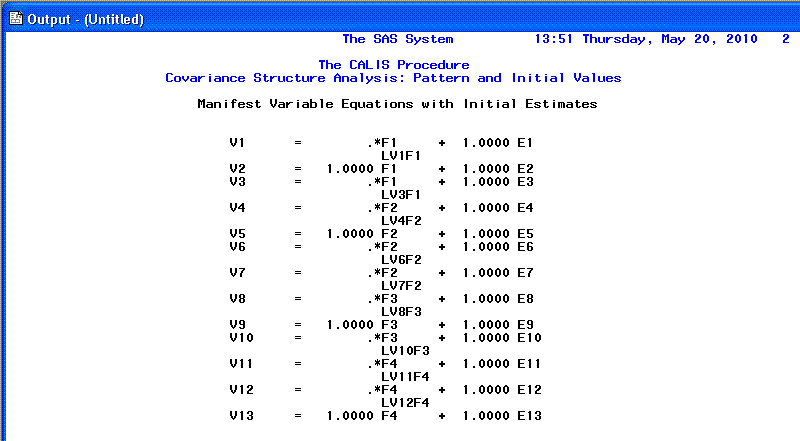
The third page of the output contains a listing of
the latent variable parameters to be estimated, the variances, and the
covariances to be estimated.

The fourth page and fifth pages show the general
components of the model (e.g. number of variables, number of
informations, number of parameters, etc.); as well as the descriptive
statistics and covariance matrix for the variables entered in the
model. The covariance matrix starts on the fourth page and continues
onto the fifth page.

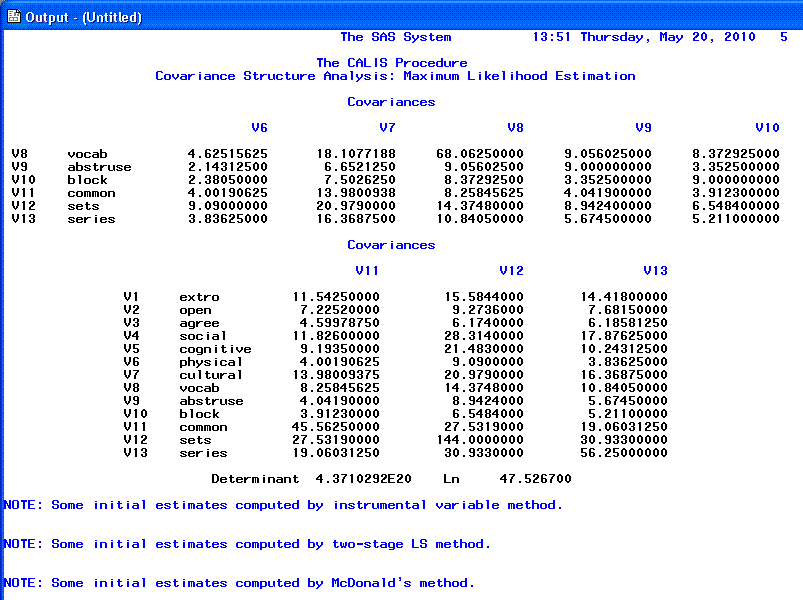
The 6th page provides the initial parameter
estimates.

The 7th page includes the iteration history. Often
it is important to focus on the last line of the Optimization results
(left side of the bottom of the page) which states whether or not
convergence criterion was satisfied.
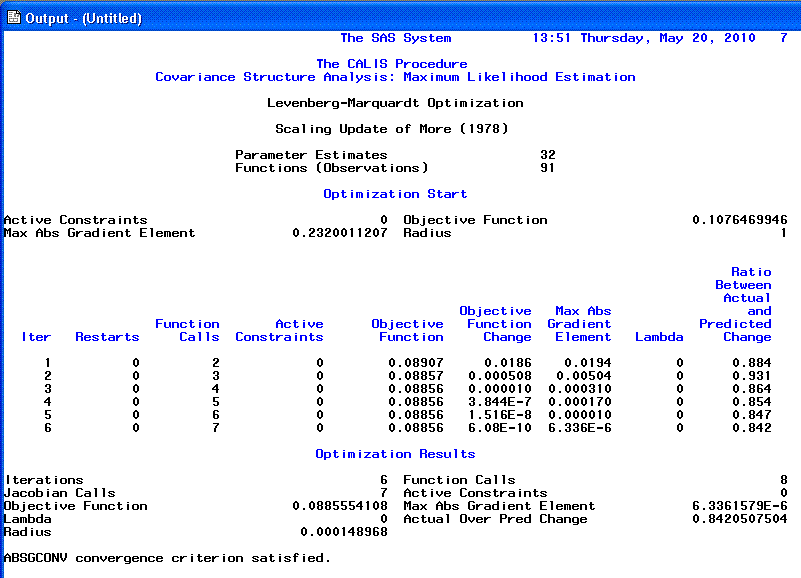
The 8th and 9th pages contain the predicted
covariance matrix, which is used for comparison to the matrix of
association (original covariance matrix) to produce residual values.


The 10th page displays fit indices. As you can
see, a fairly comprehensive list is provided. Please note that although
Chi-square is displayed it should not be used as an interpretation of
goodness-of-fit due to the large sample sizes necessary for SEM (which
inflates the chi-square statistic to the point of meaninglessness).
Some of the more commonly reported fit indices are the RMSEA (root mean
square error of approximation), which when below .05 indicates good
fit; the Schwarz's Bayesian Criterion (also called BIC; Bayesian
Information Criteria), where the smaller the value (i.e. below zero)
the better the fit; and the Bentler & Bonnett's Non-normed
Index (NNFI) as well as the Bentler & Bonnett's normed fit
index (NFI)--both of which should be greater than .90 and above to
indicate good fit.

Page 11 and 12 provide the Raw
residual matrix and the ranking of the 10 largest
Raw residuals.
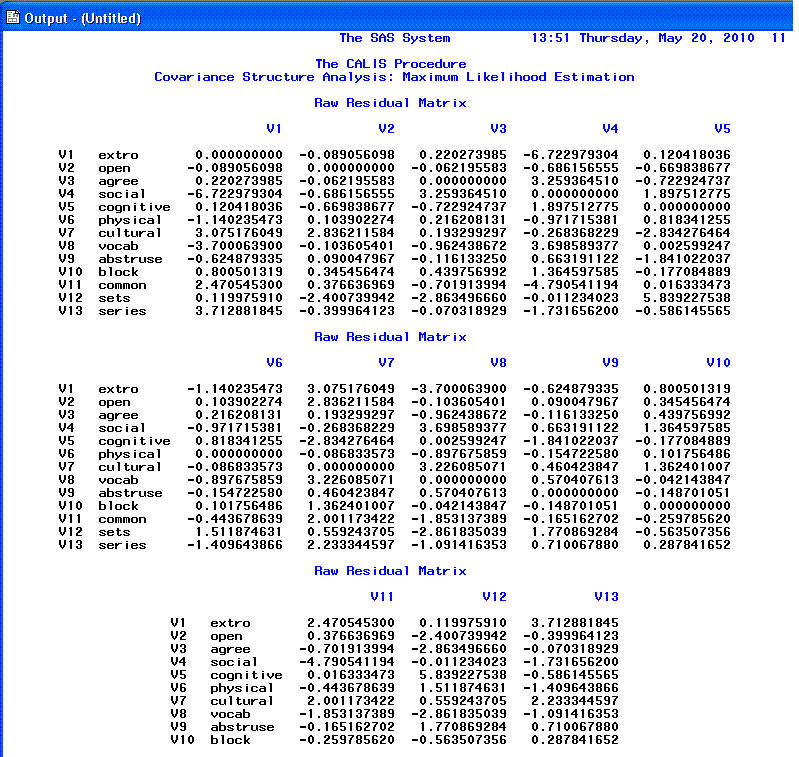
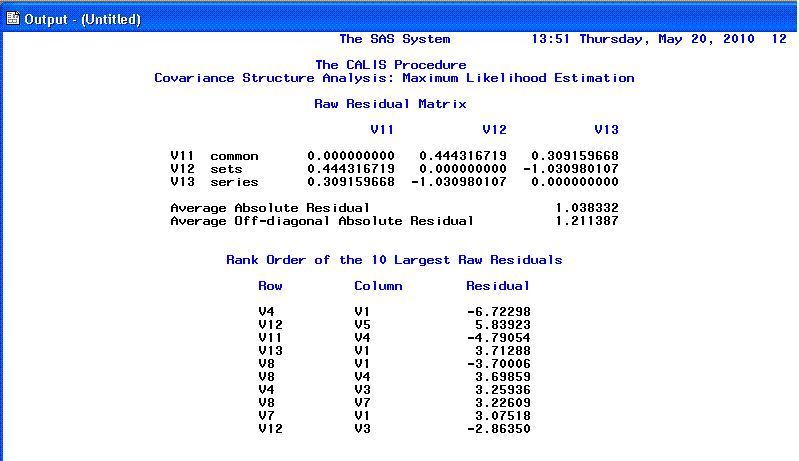
The 13th and 14th pages show the Standardized
residual matrix and the 10 largest
Standardized residuals; we expect values close to zero which
indicates good fit. Any values greater than |2.00| indicates lack of
fit and should be investigated. This is really the heart of evaluating
goodness of fit; if fit is truly good, you would see virtually no
difference between the original covariance matrix and the predicted
covariance matrix (i.e. each of the residuals would be zero). Here in
this example, we have a few values greater than |2.00| which is a bit
worrisome.


The 15th page displays a sideways histogram of the
distribution of the
Standardized residuals. Generally we expect to see a normal
distribution of residuals with no values greater than |2.00|. Here we
see a couple of values in each tail of the distribution of residuals
which are slightly larger than we would like to see.

The 16th page displays our loadings (coefficients)
in Raw form, as well as t-values and standard
errors for the t-values associated with each.
Remember that t-values for coefficients (here
loadings) are statistically significant (p <
.05, two-tailed) if their absolute value is greater than 1.96; meaning
they are significantly different from zero. If the t-value
is greater than 2.58, then p < .01 and if
the t-value is greater than 3.29, then
p < .001. It is also recommended
that a review of the standard errors be performed, as extremely small
standard errors (those very close to zero) may indicate a problem with
fit associated with one variable being linearly dependent upon one or
more other variables. Here, all our t-values for
our factor loadings are greater than 3.29 and none of our standard
errors are noticeably low (i.e. less than .0099 for instance). We also
notice the four loadings we fixed at 1.000 (V2, V5, V9, & V13).

On the 17th page, we see estimated paths in raw
scale, estimated variance parameters and the estimated covariance
between our F3 and F4 disturbance terms; each with t-values
and standard errors for the t-values. All of our t-values
were greater than 3.29 and therefore, significantly different from zero
(p < .001). Notice at the top the variance
estimates we find F1 as asked for in the syntax. This was the only
factor we estimated variance for because, it was our only exogenous
factor.

The 18th page provides Standardized
factor loadings (coefficients; analogous to
β).
These are what get reported both in text descriptions and in
figures/diagrams. You will also notice they are identical to what we
found in our verification of the Measurement Model in the previous
tutorial.

The 19th page displays our standardized
path estimates (also analogous to
β
and reported in text descriptions and diagrams) and the
'Squared Multiple Correlations'. The R-square column gives us an idea
of how well our manifest variables reflect the latent factors because,
these values are interpreted as the percentage of variance accounted
for in our manifest variables by their respective factors. As an
example; we could interpret V1 (Extroversion) as having 30.004% of its
variance accounted for by F1 (Personality). You'll notice, the R? value is simply the
square of the standardized loading (e.g. .5481? = .3004).
Furthermore, if we square our E1 term (.8364; previous page), we get
.6996, which when added to the variance accounted for by the factor
(.3004) gives us the complete standardized variance of our V1 variable:
1.00. This confirms our classical test theory perspective of observed
score = true score (the amount of the latent factor) + error.

If we had asked for modification indices, the 20th
page would begin displaying them. However we did not specify them here
because, as discussed previously they are based on chi-square and
chi-square does not provide an honest measure of goodness-of-fit.
Below you will find our completed Structural Model
diagram with standardized path coefficients. Notice, the disturbance
terms do not get flagged, even though we did have t-values
for them.
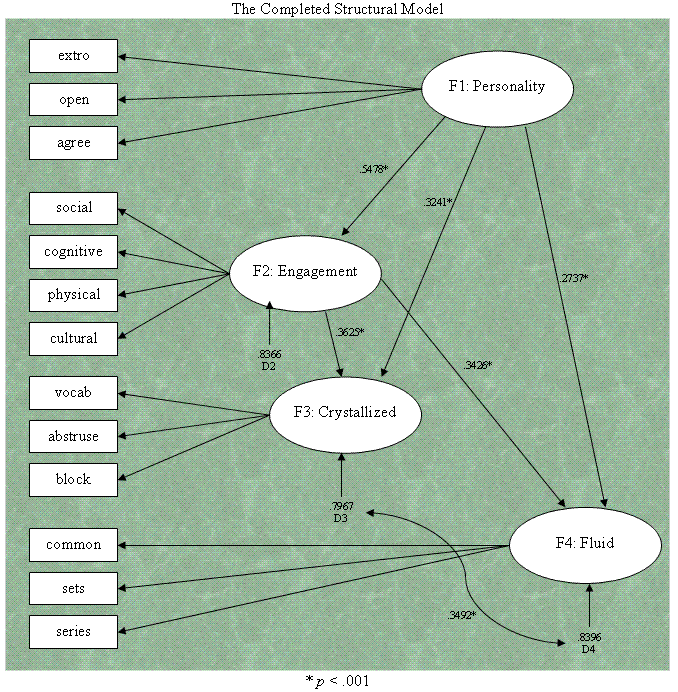
This concludes the tutorial on Structural Equation
Modeling.
Please realize, this tutorial
is not an exhaustive review, merely an introduction. It is not meant to
be a replacement for one or several good textbooks.
|


